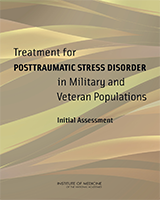NCBI Bookshelf. A service of the National Library of Medicine, National Institutes of Health.
Committee on the Assessment of Ongoing Effects in the Treatment of Posttraumatic Stress Disorder; Institute of Medicine. Treatment for Posttraumatic Stress Disorder in Military and Veteran Populations: Initial Assessment. Washington (DC): National Academies Press (US); 2012 Jul 13.

Treatment for Posttraumatic Stress Disorder in Military and Veteran Populations: Initial Assessment.
Show detailsPosttraumatic stress disorder (PTSD) is one of the signature injuries of the U.S. engagements in Iraq and Afghanistan. Of the more than 2.6 million active-duty, National Guard, and reserve service members who have been deployed to Operation Enduring Freedom (OEF) in Afghanistan since 2001 and Operation Iraqi Freedom (OIF) since 2003, an estimated 13–20% of them have or may develop PTSD. Managing PTSD in those populations is a huge task for the Department of Defense (DoD) and the Department of Veterans Affairs (VA). The DoD and the VA have responded with substantial funding to foster research, develop programs, and initiate services to combat PTSD. Both departments are making strides in identifying and treating people who have PTSD, but there are many obstacles to the achievement of effective and timely treatments, from identifying those at risk for PTSD to using the best evidence-based treatments—psychotherapy, pharmacotherapy, or some combination. Diagnostic procedures and treatment options are not standardized with respect to who uses which approach and when. There is a need to ensure that service members and veterans who seek treatment receive it in a timely and thorough manner, and to make treatments available to those who are in remote locations or for whom access to treatment is difficult. Research is being conducted to identify the physiologic bases of reactions to trauma and to identify biomarkers for preventing and diagnosing PTSD, and for treating it.
The present two-phase Institute of Medicine (IOM) study is particularly timely, given the recent conclusion of OIF and the expectation that OEF will be winding down in the next few years. The charge given to this committee represents a serious commitment of the DoD and the VA to address health care issues surrounding service members and veterans who have PTSD. This phase 1 report summarizes much of the literature on the burden of PTSD in service members and veterans, including National Guard and reservists, and explores the options available in the DoD and the VA for the prevention of, diagnosis of, and treatment for PTSD. In the second phase of its work, the committee will focus on the evaluation of data provided by the DoD and the VA and will investigate cost considerations, new neurobiologic findings, and the use of complementary and alternative treatments. Although the committee did visit one congressionally mandated site for this report (Fort Hood, Texas), in phase 2 it will undertake visits to at least two other Army sites—Fort Bliss, Texas, and Fort Campbell, Tennessee—and it hopes to visit other military bases and VA medical facilities to gain an appreciation of real-world successes and problems related to the diagnosis of and treatment for PTSD in these settings. The committee recognizes the burden that PTSD poses for many service members, veterans, and their families, and the pressing need to prevent it, diagnosis it, and treat for it in those who have given so much for this country.
The committee gratefully acknowledges the many individuals and groups who generously gave their time and expertise to share their insights on particular aspects of PTSD, who provided reports and data, and who answered queries about their work and experience in dealing, personally and professionally, with PTSD. Among the many people who helped the committee are staff of the DoD and the VA, researchers, staff of veteran and service member organizations, and members of the public who attended the committee’s open meetings. The committee also visited U.S. Army Garrison Fort Hood in Killeen, Texas, and expresses its appreciation for the time, insights, and personal stories offered by a variety of base staff, mental health providers, and service members who have PTSD and their families. The committee is also grateful to Roberta Wedge, who served as study director for this project, and to the IOM staff members who contributed to this project: Rebecca Hebner, Margot Iverson, Heidi Murray-Smith, Anne Styka, and Joi Washington. A thank you is also extended to William McLeod, who conducted database and literature searches.
Sandro Galea, Chair Committee on the Assessment of Ongoing Efforts in the Treatment of Posttraumatic Stress Disorder
- Preface - Treatment for Posttraumatic Stress Disorder in Military and Veteran Po...Preface - Treatment for Posttraumatic Stress Disorder in Military and Veteran Populations
Your browsing activity is empty.
Activity recording is turned off.
See more...